Climbing out of “The Great Recession”, many state governments found themselves faced with gaping budget shortfalls. A popular solution has been downsizing government work forces and reducing the power of public sector unions.
Wisconsin Governor Scott Walker became a mascot for the cause earlier this year when he began a push to take away collective bargaining rights from public workers in his state, a step so drastic that the state senate Democrats found it necessary to flee to Illinois to prevent a vote on the matter (which eventually became law anyway). Republican governors John Kasich (OH), Chris Christie (NJ), and Rick Scott (FL) all stirred up controversy for looking for similar places to scale back.
But while the most publicized and most agressive anti-union fights have been in states with newly elected Republican governors, unions are being pinched in more traditionally friendly democratic territory as well.
The paths to fiscal austerity chosen by Governors Andrew Cuomo of New York, Dan Malloy of Connecticut, and Martin O’Malley of Maryland have all included a degree of grappling with their public sector unions.
In the past week both New York and Connecticut went through dramatic overhauls of their union contracts and state payrolls. Starting July 12th Governor Malloy began issuing layoffs to state workers as part of his plan to cut upwards of 6,000 jobs and close the state’s $1.6 billion budget deficit.
Malloy had been negotiating for months with the State Employees Bargaining Agent Coalition, which represents 15 different unions across the state. However, after the agreed-to concession plan wasn’t ratified by union members at the 80% super-majority required by their bylaws, Malloy said he was left with no choice but to move ahead with layoffs. In response, union leaders earlier this week voted to change their bylaws to allow concession agreements to be ratified by a simple majority of union membership. According to a recent CT Mirror report, among the jobs slated to be cut if agreement can’t be reached are 4,328 currently-held full-time positions, with most of those coming from the Departments of Transportation, Corrections, and Developmental Sciences.
Wary of facing similar layoffs, New York state employees are working to negotiate their union contracts in a way that allows their members to keep their jobs but will save the state money in salary and benefits over the next few years. The latest proposed cuts are expected to be painful to the average state worker who makes $40,000 a year,but should save New York from making the same personnel cuts as Connecticut.
On Saturday, Cuomo’s office announced that a deal had been reached with the Public Employees Federation (the state’s second largest public employee union). The deal would put members under a three year pay freeze, forgoing a scheduled three percent annual raise, and require workers to pay between two and six percent more of their health insurance premiums. It is expected to prevent 9,800 statewide layoffs and save New York $2.75 billion. In a press release upon the completion of the deal Governor Cuomo claimed “This agreement reflects the financial reality of the times. I am pleased that we could avoid these layoffs, protect the workforce and the taxpayer”.
Cuomo also vetoed a bill last week that would allow school districts to borrow more to pay into pension funds, claiming that the interest on the loans would be too much of a burden on future generations of tax payers.
Although New York Unions were displeased with the reality of the situation, union leaders have been working tirelessly to urge their members to vote for the new contract. Abraham Benjamin, a union leader based out of the Bronx, who has been working to convince fellow members to sign on to the new deal told the New York Times Saturday, “I won’t say I like it, but in the environment that we are in, I feel it’s a good deal,” he said. “I explain to them that they can hold out as much as they want, but we also have to be realistic.”
Even in Maryland, Governor Martin O’Malley (Chair of the Democratic Governors Association) had to increase the percent that state workers paid into their pension funds. Claiming on Monday’s Daily Rundown that it “didn’t make a lot of headlines” and “nobody liked it”. O’Malley explained that the difference between Maryland and New Jersey or Wisconsin was that they did not belittle teachers and service employees during negotiations.
As controversial and painful these cuts are expected to be, Cuomo, Malloy, and O’Malley remain popular. Governor Cuomo still has an approval rating near the 60’s and Malloy, although generating less buzz, remains positive in recent polls.
Ed Note: This post has been updated.









